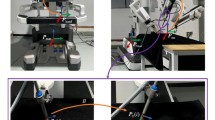Abstract
This work introduces a modern and intuitive geometric language to support and to enhance the handling of different tasks in medical robot vision. By reformulating screw theory (generalization of quaternions) in the conformal geometric algebra framework, we address the hand eye calibration, 3D model registration using Kinect, interpolation, haptics, virtual reality, graphics engineering, navigation and guided surgery. The contribution of this work is the use of conformal geometric algebra to solve some key computational issues in medical robot vision without the need to leave the mathematical framework. The experimental analysis shows promising possibilities for the use of this powerful geometric language to handle multiple tasks in minimal invasive medical robotics. For this goal, we use the geometric algebra language as a vehicle between the surgeon, haptics and the organ in the virtual and real world, this language relate the surgeon approach stimulating the surgeon’s intuition based on the utilization of geometric entities and geometric properties of the organ and the surgery itself. Readers can use this geometric language for different applications in graphic engineering and robotics as well.
























Similar content being viewed by others
References
Ablamowicks R eCLIFFORD Software packet using Maple for Clifford algebra. computations. http://math.tntech.edu/rafal
Bayro-Corrochano E (2002) Motor algebra approach for visually guided robotics. Pattern Recognit 35:279–294
Bayro-Corrochano E, Refugio V (2002) Geometric preprocessing and neurocomputing for pattern recognition and pose estimation. Pattern Recognit 36(12):2909–2926
Bayro-Corrochano E (2003) Modeling the 3D kinematics of the eye in the geometric algebra framework. Pattern Recognit 36(12):2993–3012
Bayro-Corrochano E (2010) Geometric computing: for wavelet transforms, robot vision, learning, control and action. Springer, London
Barrett-Technology. http://www.barrett.com/robot/index.html
Bayro-Corrochano E, Reyes-Lozano L, Zamora-Esquivel J (2006) Conformal geometric algebra for robotic vision. J Math Imaging Vis 24:55–81
Bayro-Corrochano E, Zamora-Esquivel J (2007) Differential and inverse kinematics of robot devices using conformal geometric algebra. Robotica 25(1):43–61
Bayro-Corrochano E, Reyes-Lozano L, Zamora-Esquivel J (2006) Conformal geometric algebra for robotic vision. J Math Imaging Vis 24:55–81
Bayro-Corrochano E, Daniilidis K, Sommer G (2000) Motor algebra for 3D kinematics. The case of the hand–eye calibration. J Math Imaging Vis 13:79–99
Chen H (1991) A screw motion approach to uniqueness analysis of head-eye geometry. In: IEEE conference on computer vision and pattern recognition, pp 145–151, Maui, Hawaii, June 3–6
Dietmar Hildenbrand. http://www.gaalop.de
Etzel KR, McCarthy JM (1996) Spatial motion interpolation in an image space of so(4). In: Proceedings of the 1996 ASME design engineering technical conference and computers in engineering conference
Garza-Burgos M, Sanchez-Orozco E, Bayro-Corrochano E (2016) Medical robot vision using the conformal geometric algebra framework. In: IEEE/RAS conference on Humanoids’2016, pp. 1087–1093, Cancun, Mexico, November 15–17
Hestenes D, Sobczyk G (1984) Clifford algebra to geometric calculus: a unified language for mathematics and physics. D. Reidel, Dordrecht
Jüttler B (1994) Visualization of moving objects using the dual quaternion curves. Comput Graph 18(3):315–326
Klawitter D (2010) Documentation-Kinematic Toolbox. Technische Universität Dresden
Kavan L, Collins S, Zara J, O’Sullivan C (2006) Geometric skinning with approximate dual quaternion blending. Technical report TCD-CS-2006-46, The University of Dublin, Trinity College
Li H, Hestenes D, Rockwood A (2001) Generalized homogeneous coordinates for computational geometry. In: Somer G (ed) Geometric computing with clifford algebras. Springer, Heidelberg, pp 27–52
Machucho-Cadena R, Rivera-Rovelo J, Bayro-Corrochano E (2014) Geometric techniques for 3D tracking of ultrasound sensor, tumor segmentation in ultrasound images, and 3D reconstruction. J Pattern Recognit 47:1968–1987
Prautzch H, Boehm W, Pauluszny M (2002) Bézier and B-sppline techniques. Springer, Berlin
Passino KM (1998) Fuzzy control. Addison-Wesley, Reading
Sepúlveda-Cervantes G, Portilla-Flores EA (2015) Orthogonal approach k for haptic rendering algorithm based in conformal geometric algebra. Appl Math Inf Sci 9(1):113–124
Soria-Garcia G, Altamirano-Gómez G, Ortega-Cisneros S, Bayro-Corrochano E (2016) FPGA implementation of a geometric voting scheme for the extraction of geometric entities from images. Adv Appl Clifford Algebras 26(2):513–884
Soria-Garcia G, Garza-Burgos M, Ureña-Ponce O, Ortega-Cisneros S, Bayro-Corrochano E (2017) Speed up of conformal geometric entities interpolation using FPGA. Adv Appl Clifford Algebras (submitted)
Resch K (2006) Transendoscopy and ultrasound for neurosonography. Springer, Berlin
Funding
The study was funded by the CONACYT Project 2012-01 No. 178222 and A. M. Garza-Burgoas thanks for her CONACYT Ph.D. scholarship.
Author information
Authors and Affiliations
Corresponding author
Ethics declarations
Conflict of interest
The authors declare that they have no conflict of interest.
Additional information
Publisher's Note
Springer Nature remains neutral with regard to jurisdictional claims in published maps and institutional affiliations.
Rights and permissions
About this article
Cite this article
Bayro-Corrochano, E., Garza-Burgos, A.M. & Del-Valle-Padilla, J.L. Geometric Intuitive Techniques for Human Machine Interaction in Medical Robotics. Int J of Soc Robotics 12, 91–112 (2020). https://doi.org/10.1007/s12369-019-00545-8
Accepted:
Published:
Issue Date:
DOI: https://doi.org/10.1007/s12369-019-00545-8




